Oakland, California
Oakland | |
|---|---|
Oakland and Berkeley Hills | |
|
PDT) | |
| ZIP Codes | 94601–94615, 94617-94624, 94649, 94659–94662, 94666[14] |
| Area codes | 510/341 |
| FIPS code | 06-53000 |
| GNIS feature IDs | 277566, 2411292 |
| Website | www [15][16][17] |
Oakland is the most populous city in and the county seat of Alameda County, California, United States. A major West Coast port, Oakland is the largest city in the East Bay region of the San Francisco Bay Area, and the third-largest city overall in the Bay Area. With a population of 440,646 in 2020,[13] it serves as the Bay Area's trade center: the Port of Oakland is the busiest port in Northern California, and the fifth- or sixth-busiest in the United States.[18] A charter city,[19] Oakland was incorporated on May 4, 1852, in the wake of the state's increasing population due to the California gold rush.[4]
Oakland's territory covers what was once a mosaic of
History
Ohlone era
The earliest known inhabitants were the Huchiun natives, who lived there for thousands of years. The Huchiun belonged to a linguistic grouping later called the Ohlone (a Miwok word meaning "western people").[22] In Oakland, they were concentrated around Lake Merritt and Temescal Creek, a stream that enters the San Francisco Bay at Emeryville.
Spanish and Mexican eras
In 1772, the area that later became Oakland was colonized, along with the rest of California, by Spanish settlers for the king of Spain. In the early 19th century, the Spanish crown granted the East Bay area to Luis María Peralta for his Rancho San Antonio. The grant was confirmed by the successor Mexican republic upon its independence from Spain.[23] Upon his death in 1842, Peralta divided his land among his four sons. Most of Oakland was within the shares given to Antonio Maria and Vicente.[24] The portion of the parcel that is now Oakland was called Encinar (misrendered at an early date and carried forward as "encinal") – Spanish for "oak grove" – due to the large oak forest that covered the area, which eventually led to the city's name.[5]
According to Stanford University historian Albert Camarillo, the Peralta family struggled to keep their land after the incorporation of California into the United States after the Mexican–American War. Camarillo claims the family was the victim of targeted racial violence. He writes in Chicanos in California, "They lost everything when squatters cut down their fruit trees, killed their cattle, destroyed their buildings, and even fenced off the roads leading to the rancho. Especially insidious were the actions of attorney Horace Carpentier, who tricked Vicente Peralta into signing a 'lease' which turned out to be a mortgage against the 19,000-acre rancho. The lands became Carpentier's when Peralta refused to repay the loan he believed was fraudulently incurred. The Peraltas had no choice but to abandon the homesite they had occupied for two generations."[25]
City beginnings

In 1851, three men—Horace Carpentier, Edson Adams, and Andrew Moon—began developing what is now downtown Oakland.[26] In 1852, the Town of Oakland was incorporated by the state legislature.[27] During this time, Oakland had 75–100 inhabitants, two hotels, a wharf, two warehouses, and only cattle trails. Two years later, on March 25, 1854, Oakland re-incorporated as the City of Oakland.[28] Horace Carpentier was elected the first mayor, though a scandal ended his mayorship in less than a year.[citation needed] In 1853, a preparatory academy was founded in Oakland that soon became the College of California, and in 1869, the first campus of the University of California, the university moved just north to Berkeley in the 1870s.[29]
During the 1850s, just as gold was discovered in California, Oakland started growing and further developing because land was becoming too expensive in San Francisco.[30] People in China were struggling financially as a result of the First Opium War, the Second Opium War, and the Taiping Rebellion, so they began migrating to Oakland, many of whom were recruited to work on railroads. However, the Chinese struggled to settle because they were discriminated against by the white community and their living quarters were burned down on several occasions.[31][page needed]
The city and its environs quickly grew with the railroads, becoming a major rail terminal in the late 1860s and 1870s. In 1868, the Central Pacific constructed the Oakland Long Wharf at Oakland Point, the site of today's Port of Oakland.[32]
A number of
1900–1950s
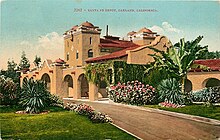
Oakland was one of the worst affected cities in California that was impacted by the San Francisco plague of 1900–1904. Quarantine measures were set in place at the Oakland ports requiring the authorities at the port to inspect the arriving vessels for the presence of infected rats.[33] Quarantine authorities at these ports inspected over a thousand vessels per year for plague and yellow fever. By 1908, over 5,000 people were detained in quarantine.[34] Hunters were sent to poison the affected areas in Oakland and shoot the squirrels, but the eradication work was limited in its range because the State Board of Health and the United States Public Health Service were only allotted about $60,000 a year to eradicate the disease. During this period Oakland did not have sufficient health facilities, so some of the infected patients were treated at home.[35]
The State Board of Health along with Oakland also advised physicians to promptly report any cases of infected patients.[36] Yet, in 1919 it still resulted in a small epidemic of Pneumonic plague which killed a dozen people in Oakland.[36] This started when a man went hunting in Contra Costa Valley and killed a squirrel. After eating the squirrel, he fell ill four days later and another household member contracted the plague. This in turn was passed on either directly or indirectly to about a dozen others.[37] The officials in Oakland acted quickly by issuing death certificates to monitor the spread of plague.[36]
Incorporation

At the time of incorporation in 1852, Oakland had consisted of the territory that lay south of today's major intersection of San Pablo Avenue, Broadway, and Fourteenth Street. The city gradually annexed farmlands and settlements to the east and the north. Oakland's rise to
In 1908, the lawyer, former miner, and newspaper owner Homer Wood (1880–1976) suggested to his friend Frank Bilger of Blake and Bilger Rock Quarry and Paving Company that he organize a gathering to establish a
In 1917,
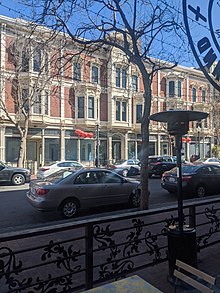
Oakland expanded during the 1920s, as its population expanded with factory workers. Approximately 13,000 homes were built in the 3 years between 1921 and 1924,[44] more than during the 13 years between 1907 and 1920.[45] Many of the large downtown office buildings, apartment buildings, and single-family houses still standing in Oakland were built during the 1920s; they reflect the architectural styles of the time.
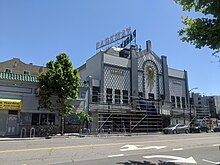

Russell Clifford Durant established Durant Field at 82nd Avenue and East 14th Street in 1916.
During World War II, the East Bay Area was home to many war-related industries. Oakland's Moore Dry Dock Company expanded its shipbuilding capabilities and built over 100 ships. Valued at $100 million in 1943, Oakland's canning industry was its second-most-valuable war contribution after shipbuilding. The largest canneries were in the Fruitvale District, and included the Josiah Lusk Canning Company, the Oakland Preserving Company (which started the Del Monte brand), and the California Packing Company.[49]
President
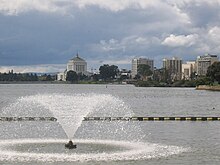
In 1946,
After the war, as Oakland's shipbuilding industry declined and the automobile industry went through restructuring, many jobs were lost.[
The
1960–1999
In 1960, Kaiser Corporation opened its new headquarters; it was the largest skyscraper in Oakland, as well as "the largest office tower west of Chicago" up to that time.[57] In the postwar period, suburban development increased around Oakland, and wealthier residents moved to new housing. Despite the major increases in the number and proportion of African Americans in the city, in 1966 only 16 of the city's 661 police officers were black. Tensions between the black community and the largely white police force were high, as expectations during the civil rights era increased to gain social justice and equality before the law. Police abuse of blacks was common.[58][59]
Students
As in many other American cities during the 1980s, crack cocaine became a serious problem in Oakland. Drug dealing in general, and the dealing of crack cocaine in particular, resulted in elevated rates of violent crime, causing Oakland to consistently be listed as one of America's most crime-ridden cities.[61]
In 1980, Oakland's Black population reached its 20th-century peak at approximately 47% of the overall city population.[62]
The 6.9
On October 20, 1991, a massive
During the mid-1990s, Oakland's economy began to recover as it transitioned to new types of jobs. In addition, the city participated in large development and urban renewal projects, concentrated especially in the downtown area, at the Port of Oakland, and at the Oakland International Airport.[65]
21st century
After his 1999 inauguration, Oakland Mayor Jerry Brown continued his predecessor Elihu Harris' public policy of supporting downtown housing development in the area defined as the Central Business District in Oakland's 1998 General Plan.[66] Brown's plan and other redevelopment projects were controversial due to potential rent increases and gentrification, which would displace lower-income residents from downtown Oakland into outlying neighborhoods and cities.[67]
Due to
African-Americans dropped to 28% of Oakland's population in 2010, from nearly half in 1980, due to fast-rising rents and an extreme housing crisis in the region.[71]
The city inspected warehouses and live/work spaces after a fire broke out in the Ghost Ship warehouse, killing 36 people in 2016.[72]
Oakland is the second U.S. city, after
In November 2019, two homeless mothers and their children moved into a vacant three-bedroom house in West Oakland. The group, calling themselves Moms 4 Housing, said their goal was to protest what they said was a large number of vacant houses in Oakland owned by redevelopment companies while the city experienced a housing crisis.[75] Two months later they were evicted from the house by three dozen sheriff's deputies, as hundreds of supporters demonstrated in favor of the women.[76] The incident received nationwide coverage.[77] The company that owns the house later said they would sell it to a nonprofit affordable housing group.[78] As of 2019, Oakland's per-capita homeless rate was higher than San Francisco and Berkeley. Between 2014 and 2020, Oakland strengthened its protections for tenants in order to reduce the displacement of its long-time residents. Between January 2020 and March 2022, Oakland suffered a disproportionate death toll from the COVID-19 pandemic and Deltacron hybrid variant within the San Francisco Bay Area.
In 2023, prior to and during the Covid pandemic, Oakland became the first city in American history to lose three professional major league sports teams to other cities within a span of five years.[79]
Geography
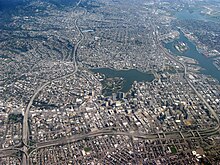

Oakland is in the eastern region of the San Francisco Bay.
The United States Census Bureau says the city's total area is 78.0 square miles (202 km2), including 55.8 square miles (145 km2) of land and 22.2 square miles (57 km2) (28.48 percent) of water.
Oakland's highest point is near Grizzly Peak Blvd, east of Berkeley, just over 1,760 feet (540 m)
Oaklanders refer to their city's terrain as "the flatlands" and "the hills". Until recent waves of gentrification, these terms also symbolized Oakland's deep economic divide, with "the hills" being more affluent communities. About two-thirds of Oakland lies in the flat plain of the East Bay, with one-third rising into the foothills and hills of the East Bay range.
Ruptures along the nearby San Andreas Fault caused severe earth movement in the San Francisco Bay Area in 1906 and 1989. San Andreas quakes induces creep (movement occurring on earthquake faults) in the Hayward fault, which runs directly through Oakland, Berkeley, San Jose and other Bay Area cities.[81]
Neighborhoods

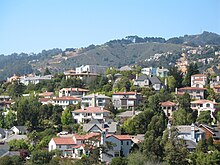
Oakland has more than 50 distinct neighborhoods. The city's greater divisions include downtown Oakland and its greater Central Business District, Lake Merritt, East Oakland, North Oakland, West Oakland, and the Oakland Hills. East Oakland, which includes the East Oakland Hills, encompasses more than half of Oakland's land area, stretching from Lakeshore Avenue on the east shore of Lake Merritt southeast to the San Leandro border. North Oakland encompasses the neighborhoods between downtown and Berkeley and Emeryville. West Oakland is the area between downtown and the Bay, partially surrounded by the Oakland Point, and encompassing the Port of Oakland. In 2011, Oakland was ranked the tenth most walkable city in the United States by Walk Score.[82]
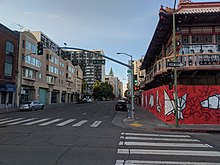
Lake Merritt, an urban estuary near downtown, is a mix of fresh and salt water draining in and out from the Oakland Harbor at the San Francisco Bay and one of Oakland's most notable features.[83] It was designated the United States' first official wildlife refuge in 1870.[84] Originally a marsh-lined wildlife haven, Lake Merritt was dredged and bordered with parks from the 1890s to the 1910s. Despite this reduction in habitat, Oakland is home to a number of rare and endangered species, many of which are localized to serpentine soils and bedrock. Lake Merritt is surrounded by residential and business districts, including downtown and Grand Lake.
The city of Piedmont, incorporated in Oakland's central foothills after the 1906 earthquake, is a small independent city surrounded by the city of Oakland.
Climate
Oakland has a
Based on data gathered by the National Oceanic and Atmospheric Administration, Oakland is ranked No. 1 in climate among U.S. cities.[85] Oakland's climate is typified by the temperate and seasonal Mediterranean climate. Summers are usually dry and warm and winters are cool and damp. It has features found in both nearby coastal cities such as San Francisco and inland cities such as San Jose, making it warmer than San Francisco and cooler than San Jose. Its position on San Francisco Bay across from the Bay Bridge means the northern part of the city can have cooling maritime fog. It is far enough inland that the fog often burns off by midday, allowing it to have typically sunny California days. The hills tend to have more fog than the flatlands, as the fog drifts down from Berkeley.
The
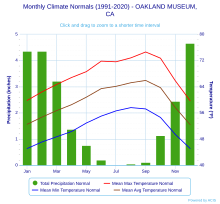
Oakland, like much of Northern California, is susceptible to winter rainstorms and Atmospheric rivers. The wettest “rain year” was from July 1997 to June 1998 with 47.76 inches (1,213.1 mm) and the driest from July 2019 to June 2020 with 9.28 inches (235.7 mm). The most rainfall in one month was 15.35 inches (390 mm) in January 1911. The most rainfall in 24 hours was 4.29 inches (109 mm) on January 26, 2008.[86] Rainfall near the bayfront is only 23 inches (580 mm), but is higher in the Oakland Hills to the east (up to 30 inches [760 mm]), with nearly all precipitation falling between November and April.
Overnight lows are mild. Oakland seldom experiences warm nights with the warmest recorded night of 72 °F (22 °C) in September 1971 and an average of 64 °F (18 °C) for the annual warmest low.[87] The coldest day of the year averages a mild 50 °F (10 °C) and has never been recorded below 36 °F (2 °C).[87]
The
| Climate data for Oakland, California (1991–2020 normals, extremes 1970–present) | |||||||||||||
|---|---|---|---|---|---|---|---|---|---|---|---|---|---|
| Month | Jan | Feb | Mar | Apr | May | Jun | Jul | Aug | Sep | Oct | Nov | Dec | Year |
| Record high °F (°C) | 78 (26) |
82 (28) |
88 (31) |
97 (36) |
105 (41) |
106 (41) |
103 (39) |
100 (38) |
109 (43) |
103 (39) |
84 (29) |
75 (24) |
109 (43) |
| Mean maximum °F (°C) | 68.6 (20.3) |
72.5 (22.5) |
76.7 (24.8) |
82.2 (27.9) |
84.2 (29.0) |
88.7 (31.5) |
86.0 (30.0) |
87.5 (30.8) |
90.6 (32.6) |
87.7 (30.9) |
77.1 (25.1) |
68.0 (20.0) |
92.6 (33.7) |
| Mean daily maximum °F (°C) | 59.8 (15.4) |
62.4 (16.9) |
64.7 (18.2) |
66.8 (19.3) |
68.6 (20.3) |
71.8 (22.1) |
71.6 (22.0) |
72.8 (22.7) |
74.6 (23.7) |
72.7 (22.6) |
65.8 (18.8) |
59.7 (15.4) |
67.6 (19.8) |
| Daily mean °F (°C) | 52.5 (11.4) |
54.7 (12.6) |
56.7 (13.7) |
58.5 (14.7) |
60.8 (16.0) |
63.4 (17.4) |
64.1 (17.8) |
65.2 (18.4) |
65.9 (18.8) |
63.7 (17.6) |
57.6 (14.2) |
52.4 (11.3) |
59.6 (15.3) |
| Mean daily minimum °F (°C) | 45.1 (7.3) |
47.1 (8.4) |
48.7 (9.3) |
50.3 (10.2) |
52.9 (11.6) |
55.0 (12.8) |
56.6 (13.7) |
57.6 (14.2) |
57.2 (14.0) |
54.6 (12.6) |
49.4 (9.7) |
45.1 (7.3) |
51.6 (10.9) |
| Mean minimum °F (°C) | 37.9 (3.3) |
40.2 (4.6) |
42.4 (5.8) |
45.0 (7.2) |
49.4 (9.7) |
51.9 (11.1) |
54.0 (12.2) |
55.6 (13.1) |
53.6 (12.0) |
49.0 (9.4) |
41.7 (5.4) |
37.5 (3.1) |
36.4 (2.4) |
| Record low °F (°C) | 30 (−1) |
29 (−2) |
34 (1) |
37 (3) |
43 (6) |
48 (9) |
51 (11) |
50 (10) |
48 (9) |
43 (6) |
36 (2) |
26 (−3) |
26 (−3) |
| Average precipitation inches (mm) | 4.35 (110) |
4.35 (110) |
3.21 (82) |
1.37 (35) |
0.75 (19) |
0.20 (5.1) |
0.00 (0.00) |
0.05 (1.3) |
0.10 (2.5) |
1.13 (29) |
2.44 (62) |
4.66 (118) |
22.61 (574) |
| Average precipitation days (≥ 0.01 in) | 10.4 | 10.0 | 10.4 | 5.9 | 3.7 | 1.1 | 0.1 | 0.3 | 0.8 | 3.0 | 6.5 | 10.5 | 62.7 |
| Source: NOAA[88][89] | |||||||||||||
Vegetation
The higher rainfall in the hills supports woods of oak, madrona, pine, fir and a few redwood groves in the wetter areas. Before being logged in the 19th century, some of the tallest redwood trees in California (used for navigation by ships entering the Golden Gate) may have stood in the Oakland Hills. One old stump 30 feet (9.1 m) in diameter can be seen near Redwood Regional Park. Sunny, drier slopes are grassy or covered in scattered oaks and chaparral brush. Australian eucalyptus trees have been extensively planted in many areas, as they come from a similar climate.
Demographics
| Census | Pop. | Note | %± |
|---|---|---|---|
| 1860 | 1,543 | — | |
| 1870 | 10,500 | 580.5% | |
| 1880 | 34,555 | 229.1% | |
| 1890 | 48,682 | 40.9% | |
| 1900 | 66,960 | 37.5% | |
| 1910 | 150,174 | 124.3% | |
| 1920 | 216,261 | 44.0% | |
| 1930 | 284,063 | 31.4% | |
| 1940 | 302,163 | 6.4% | |
| 1950 | 384,575 | 27.3% | |
| 1960 | 367,548 | −4.4% | |
| 1970 | 361,561 | −1.6% | |
| 1980 | 339,337 | −6.1% | |
| 1990 | 372,242 | 9.7% | |
| 2000 | 399,484 | 7.3% | |
| 2010 | 390,724 | −2.2% | |
| 2020 | 440,646 | 12.8% | |
| 2022 (est.) | 430,553 | −2.3% | |
| U.S. Decennial Census[90] | |||
The
Religion
This section needs expansion. You can help by adding to it. (July 2023) |
34.95% of people in Oakland are affiliated with a religion, in a total of 417 congregations.[92]
Major places of worship in Oakland include –
- 31st Street Islamic Center, Islam
- Allen Temple Baptist Church, American Baptist Churches USA and the Progressive National Baptist Convention, Inc.
- Ascension Cathedral, Greek Orthodox
- Beth Jacob Congregation, Modern Orthodox Judaism
- Cathedral of Christ the Light, Roman Catholic
- Chinese Community Church, United Methodist
- Elmhurst Seventh-day Adventist Church, Seventh-day Adventist Church
- First Congregational Church of Oakland, United Church of Christ
- First Presbyterian Church of Oakland, Presbyterian
- First Unitarian Church, Unitarian
- Green Pastures, Evangelistic Outreach Association
- His Gospel Christian Fellowship
- Islamic Cultural Center of Northern California, Islam
- Light-House Mosque, Islam
- Kingdom Hall of Jehovah's Witnesses, Jehovah's Witnesses
- Oakland California Temple, The Church of Jesus Christ of Latter-day Saints
- Oakland City Church
- Oakland Bahá'í Center
- Second Bethel Missionary Baptist Church
- St. Paul Lutheran Church, Lutheran
- St. Vartan Armenian Church, Armenian Apostolic Church
- Temple Beth Abraham, United Synagogue of Conservative Judaism
- Temple Sinai, Reform Judaism
Race and ethnicity
The
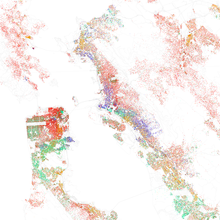
| Historical racial composition | 2022[93] | 2020 | 2010[94] | 1990[95] | 1970[95] | 1940[95] |
|---|---|---|---|---|---|---|
White
|
33.4% | 30.0% | 34.5% | 32.5% | 59.1% | 95.3% |
| —Non-Hispanic | 28.6% | 27.3% | 25.9% | 28.3% | 52.0%[a] | n/a |
Black or African American
|
22.0% | 23.8% | 28.0% | 43.9% | 34.5% | 2.8% |
| Hispanic or Latino (of any race) | 27.2% | 27.0% | 25.3% | 13.9% | 7.6%[a] | n/a |
Asian
|
15.7% | 16.1% | 16.8% | 14.8% | 4.8% | – |
From the
| Race / Ethnicity (NH = Non-Hispanic) | Pop 2000[96] | Pop 2010[97] | Pop 2020[98] | % 2000 | % 2010 | % 2020 |
|---|---|---|---|---|---|---|
White alone (NH)
|
93,953 | 101,308 | 120,187 | 23.52% | 25.93% | 27.28% |
Black or African American alone (NH)
|
140,139 | 106,637 | 91,561 | 35.08% | 27.29% | 20.28% |
Alaska Native alone (NH)
|
1,471 | 1,214 | 1,371 | 0.37% | 0.31% | 0.31% |
| Asian alone (NH) | 60,393 | 65,127 | 69,906 | 15.12% | 16.67% | 15.86% |
| Pacific Islander alone (NH) | 1,866 | 2,081 | 2,668 | 0.47% | 0.53% | 0.61% |
| Other race alone (NH) | 1,229 | 1,213 | 2,964 | 0.31% | 0.31% | 0.67% |
| Mixed race or Multiracial (NH) | 12,966 | 14,076 | 25,146 | 3.25% | 3.60% | 5.71% |
| Hispanic or Latino (any race) | 87,467 | 99,068 | 126,843 | 21.89% | 25.35% | 28.79% |
| Total | 399,484 | 390,724 | 440,646 | 100.00% | 100.00% | 100.00% |
2022 United States Census Bureau American Community Survey estimates
|
Racial Makeup of Oakland (2022)[99] White alone (31.10%) Black alone (20.56%) Native American alone (1.25%) Asian alone (15.94%) Pacific Islander alone (0.29%) Other race alone (19.59%) Two or more races (11.27%)
|
Racial/Ethnic Makeup of Oakland excluding Hispanics from Racial Categories (2022)[99] White NH (29.65%) Black NH (20.13%) Native American NH (0.23%) Asian NH (15.76%) Pacific Islander NH (0.29%) Other race NH (1.00%) Two or more races NH (6.10%) Hispanic Any Race (26.83%)
|
Racial Makeup of Hispanics in Oakland (2022)[99] White alone (5.42%) Black alone (1.60%) Native American alone (3.78%) Asian alone (0.66%) Pacific Islander alone (0.00%) Other race alone (69.30%) Two or more races (19.23%)
|
According to 2022 US Census Bureau estimates, Oakland's population declined to 430,531, and was 31.1%
White Americans are the largest racial/ethnic group at either 31.1% (including
Hispanics have been the second largest ethnic group since 2012 when they displaced the Black population. However, Black Americans still form the second largest racial group. By ethnicity, 26.8% of the total population is Hispanic-Latino (of any race) and 73.2% is Non-Hispanic (of any race).[99] The majority of Hispanics self-identify as Some Other Race (69.3%) with the remainder choosing White (5.4%), Multiracial (19.2%), Black (1.6%), American Indian and Alaskan Native (3.8%), Asian (0.7%), and Hawaiian and Pacific Islander (0.1%).[99]
The Black population is the third largest ethnic group and second largest racial group at either 20.6% (including Black Hispanics) or 20.1% excluding Black Hispanics.[99]
The Asian population continues to remain the fourth largest group at 15.9% of the population.[99]
5.1% are of English ancestry, French (except Basque), 1.4% German, 6.1% Irish - 6.2% Italian, 3.1% Norwegian, 1.1% Polish - 1.7% Scottish and 1.0%Subsaharan African 2.5%.[100]
Educational attainment and income
The greater Oakland area[specify] has the fifth largest cluster of "elite zip codes" ranked by the number of households with the highest combination of income and education.[101] 37.9% of residents over 25 years of age have bachelor's degree or higher.[102] Oakland ranked among the top cities with residents with bachelor's degrees and graduate degrees per square mile.[103]
Oakland ranks in the top 20 of American cities in median household income, with a 2012 value of US$51,863.[104] In 2012, the median income for a household in the city was US$51,863 and the median income for a family was US$59,459. The mean income for a household was US$77,888 and the mean income for a family was US$90,948. Males had a median income of US$50,140 versus US$50,304 for females.[105] The unemployment rate as of December 2013 was 9.7%.[106]
In 2007 approximately 15.3 percent of families and 17.0 percent of the general population were below the poverty line, including 27.9 percent of those under age 18 and 13.1 percent of those age 65 or over. 0.7% of the population is homeless.[107] Home ownership is 41%[107] and 14% of rental units are subsidized.[107]
As of the census[108] of 2000, 19.4% of the population and 16.2% of families were below the poverty line. Out of the total population, 27.9% of those under the age of 18 and 13.1% of those 65 and older were living below the poverty line.
Households
The census reported 382,586 people (97.9% of the population) lived in households, 5,675 (1.5%) lived in non-institutionalized group quarters, and 2,463 (0.6%) were institutionalized.
There were 153,791 households, out of which 44,762 (29.1%) had children under the age of 18 living in them, 50,797 (33.0%) were
The population was spread out, with 83,120 people (21.3%) under the age of 18, 36,272 people (9.3%) aged 18 to 24, 129,139 people (33.1%) aged 25 to 44, 98,634 people (25.2%) aged 45 to 64, and 43,559 people (11.1%) who were 65 years of age or older. The median age was 36.2 years. For every 100 females, there were 94.2 males. For every 100 females age 18 and over, there were 91.8 males.
There were 169,710 housing units at an average density of 2,175.7 per square mile (840.0/km2), of which 153,791 were occupied, of which 63,142 (41.1%) were owner-occupied, and 90,649 (58.9%) were occupied by renters. The homeowner vacancy rate was 3.0%; the rental vacancy rate was 8.5%. 166,662 people (42.7% of the population) lived in owner-occupied housing units and 215,924 people (55.3%) lived in rental housing units.
Shifting of cultures
Oakland has consistently ranked as one of the most ethnically diverse major cities in the country.[109][110] A 2019 analysis by WalletHub showed that Oakland was the most ethnoracially diverse city in the United States.[111] The city's formerly most populous ethnic group, whites, declined from 95.3% in 1940 to 32.5% by 1990, due to a combination of factors, including suburbanization. Oakland became a destination for African Americans in the Great Migration during and after World War II as they gained high-paying jobs in the defense industry. Blacks have formed a plurality in Oakland for many years, peaking in 1980 at about 47% of the population.
Oakland's Black population decreased by nearly 25 percent between 2000 and 2010.[112] The city's demographics have changed due to a combination of rising housing prices associated with gentrification and with blacks relocating to better (and in many cases more affordable) housing in Bay Area suburbs or moving to the Southern United States in a reverse migration, where conditions (including race relations) are considered to have improved in comparison to previous generations.[113][114][115] These trends and cultural shifts have led to a decline among some of Oakland's long standing black institutions, such as churches, businesses and nightclubs, which had developed during the growing years of the 1950s through 1970.[116]
In the 2010 census African Americans maintained their status as Oakland's single largest ethnic group, with 27% of the population, followed by non-Hispanic whites at 25.9%, and Hispanics of any race at 25.4%.[117] Ethnic Asians constitute 17%, followed by smaller minority groups.
Many immigrants have settled in the city. Immigrants and others have marched by the thousands down Oakland's
An analysis by the Urban Institute of
Gentrification
As of 2020, the San Francisco-Oakland Metro shows indications of having the greatest intensity of gentrification nationally, with over 31% of eligible neighborhoods gentrifying. Gentrifying neighborhoods showed significant increases in median home value, median household income, percentage of college educated residents, but also in economic inequality.[121]
Historically low-income neighborhoods have been rapidly changed by new, higher-income residents as high-wage tech workers and expensive housing have continued to push lower-wage residents out of Oakland.[121] In West Oakland, for example, median household income rose from $80,700 to $86,300 between 2010 and 2017, while the percent of population with four-year degrees rose from one-third to nearly one-half, according to the National Community Reinvestment Coalition.[122]
Big tech companies have continued to transform the communities and culture of Oakland as modern apartments have appeared, housing prices have spiked, and many prior working-class residents have moved to suburbs further inland.[123]
According to 2015 data compiled by the Bay Area Equity Atlas, 91% of low-income households of color were either in neighborhoods that were gentrifying or were at risk of gentrification at the time.[124] The number was higher for individual low-income communities, with 96% of Native American households in neighborhoods that either experienced gentrification or were at risk of being gentrified, followed by Latino households at 94%, Black households at 92%, and Asian or Pacific Islander households at 88%.[124]
Crime
| 1992 | 175[127] |
| 1995 | 153[128] |
| 1996 | 102[128] |
| 2000 | 85[129] |
| 2001 | 87[129] |
| 2002 | 113[129] |
| 2003 | 114[129] |
| 2004 | 88[129] |
| 2005 | 94[129] |
| 2006 | 148[129] |
| 2007 | 127[129] |
| 2008 | 125[129] |
| 2009 | 110[129] |
| 2010 | 95[129] |
| 2011 | 110[129] |
| 2012 | 131[129] |
| 2013 | 92[129] |
| 2014 | 86[130] |
| 2015 | 83[131] |
| 2016 | 85[131] |
| 2017 | 72[132] |
| 2018 | 75[126] |
| 2019 | 78[125] |
| 2020 | 109[125] |
| 2021 | 134[133] |
| 2022 | 120[133] |
A 2014 study by the Chief Justice Earl Warren Institute on Law & Social Policy at the
A 2007 journal article identified crime in Oakland as being fueled by the dramatic increase of street narcotics sales and use since the 1970s, with Oakland becoming a major west-coast hub for heroin and cocaine distribution. Subsequent battle for control over the lucrative narcotics trade incited gang conflicts and violence, with shootings becoming a regular occurrence. A concurrent rise in rape, robbery, burglary, auto-theft and other crimes occurred as well. Prior to 1960, there had been successful government-funded social programs whereby rebellious teens were enrolled in youth centers that would teach them proper values and improve their behavior. Similar programs since then have been inconsistent.[135]
By the 1970s, the police and Federal Bureau of Investigation (FBI) used military tactics such as SWAT teams, infiltration and counter intelligence in an attempt to counter groups such as the Black Panthers (responsible for several police ambushes), the S.L.A. and organized drug gangs such as the "69 Mob", with increases in arrests, prosecutions, and imprisonment.[135] During the first decade of the 21st century, Oakland has consistently been listed as one of the most dangerous large cities in the United States.[136]
The number of Oakland Police Department officers has varied from a low of 626 (in 1996 and in 2012) to a high of 814 (in 2002).[134] There were 723 officers at the end of 2015.[127] The city's strategic plan recommended 925 officers, and an independent study commissioned by the city in the mid-1990s recommended 1,200 officers.[137][138][139]
Among Oakland's 35 police patrol beats, violent crime remains a serious problem in specific East and West Oakland neighborhoods. In 2008, homicides were concentrated: 72% occurred in three City Council districts, District 3 in West Oakland and Districts 6 and 7 in East Oakland, although these districts have 44% of Oakland's residents.[140]
In 2012, Oakland implemented Operation Ceasefire, a gang violence reduction plan used in other cities, based in part on the research and strategies of author David M. Kennedy.[141][142][143][144]
Economy
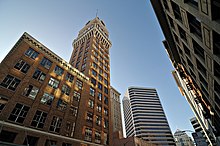
Oakland is a major West Coast port, and the fifth-busiest in the United States by cargo volume.[145] The Port of Oakland handles 99% of all containerized goods moving through Northern California, representing $41 billion worth of international trade.[146][147] There are nearly 200,000 jobs related to marine cargo transport in the Oakland area.[148] These jobs range from minimum wage hourly positions to Transportation Storage and Distribution Managers who earn an annual average salary of US$91,520.[149]
The Port of Oakland was an early innovator/pioneer in the technologies of
As of 2013[update], the San Francisco-Oakland-Hayward metropolitan area has a gross domestic product (GDP) of US$360.4 billion, ranking eighth among metropolitan areas in the United States.[153] In 2014, Oakland was amongst the best cities to start a career, the highest ranked city in California after San Francisco. Additionally, Oakland ranked fourth in cities with professional opportunities.[154] Numerous companies in San Francisco continue to expand in or migrate over to Oakland.[155]
Oakland experienced an increase of both its population and of land values in the early-to-mid first decade of the 21st century. The
Top employers
As of 2020[update], the top employers in the city were:[156]
| # | Employer | # of Employees |
|---|---|---|
| 1 | Kaiser Permanente | 12,500+ |
| 2 | County of Alameda
|
8,000+ |
| 3 | Alameda Health System | 5,300+ |
| 4 | Oakland Unified School District | 5,000+ |
| 5 | City of Oakland | 4500+ |
| 6 | Bay Area Rapid Transit | 4,000+ |
| 7 | State of California
|
3,500+ |
| 8 | Children's Hospital Oakland | 2,500+ |
| 9 | Southwest Airlines | 2,500+ |
| 10 | Sutter Bay Hospitals and Foundation | 2,000+ |
Tourism
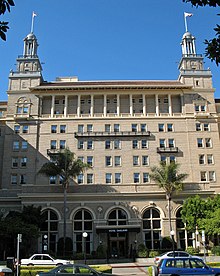
In 2013, over 2.5 million people visited Oakland, injecting US$1.3 billion into the economy.[157] Oakland has been experiencing an increase in hotel demand. Occupancy is 74%, while RevPAR (Revenue Per Available Room) increased by 14%, the highest increase of any big city in the western region of the United States.[158] Both Oakland and San Francisco were forecasted to experience the highest increases in ADR (Average daily rate).[159]
In recent years, Oakland has gained national recognition as a travel destination. In 2012, The New York Times named Oakland the top North American city to visit, highlighting its growing number of sophisticated restaurants and bars, top music venues, and increasing nightlife appeal.[160] Oakland also took the No. 16 spot in "America's Coolest Cities", ranked by metrics like entertainment options and recreational opportunities per capita, etc.[161] In 2013, Oakland topped the No. 1 spot in "America's Most Exciting Cities", notably having the most movie theaters, theater companies, and museums per square mile.[162] In "America's Most Hipster Cities", Oakland took the number-5 spot, cited for luring San Francisco "hippies" into the city.[163] Oakland has also increased its travel destination allure internationally.[164]
Arts and culture
Oakland has a vibrant art scene and claims the highest concentration of artists per capita in the United States.[165] In 2013, Oakland was designated as one of America's top twelve art communities, recognizing Downtown (including Uptown), Chinatown, Old Oakland, and Jack London Square as communities "that have most successfully combined art, artists and venues for creativity and expression with independent businesses, retail shops and restaurants, and a walkable lifestyle to make vibrant neighborhoods."[166]
Galleries exist in various parts of Oakland, with the newest additions centered mostly in the
Historically a focal point of the West Coast
Attractions

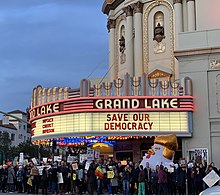
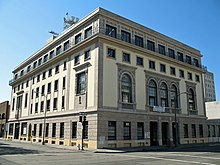
Free walking tours are offered by the City. Archived May 24, 2018, at the Wayback Machine
- African American Museum and Library at Oakland
- AXIS Dance Company
- Chabot Space and Science Center
- Children's Fairyland
- Chinatown
- Dunsmuir House
- Fox Oakland Theatre, concert venue
- Jack London Square
- Joaquin Miller Park
- bird sanctuaryin North America, Lake Merritt Garden Center, Bonsai Garden
- Lake Temescal
- Mountain View Cemetery, designed by Frederick Law Olmsted and resting place of many famous Californians
- Oakland–Alameda County Coliseum, home of baseball's Oakland Athletics, and (until January 2020) of the Oakland Raiders of the NFL
- Oakland Aviation Museum
- Oakland California Temple, includes the gardens, visitors' center, family history center, & concert hall
- Oakland Museum of California
- Oakland Public Library
- Oakland Symphony
- Oakland Zoo
- Oakland Arena, directly adjacent to the Oakland Coliseum, former home to the Golden State Warriors of the NBA
- Paramount Theatre
- Pardee Home
- Peralta Hacienda Historical Park, Museum of History and Culture
- Redwood Regional Park
- Preservation Park
- USS Potomac, Franklin D. Roosevelt's presidential yacht
Nightlife

Downtown Oakland has an assortment of bars and
Recent years have seen the growth of the Oakland Art Murmur event, occurring in the Uptown neighborhood the first Friday evening of every month.[170] The event attracts around 20,000 people along twenty city blocks, featuring live performances, food trucks, and over 30 galleries and venues.[171][172]
"There is no there there"
Gertrude Stein wrote about Oakland in her 1937 book Everybody's Autobiography "There is no there there", upon learning that the neighborhood where she lived as a child had been torn down to make way for an industrial park. The quote is usually misconstrued to refer to Oakland as a whole.[173][174]
Modern-day Oakland has made steps to rebuke Stein's claim with a statue downtown titled There. In 2005 a sculpture called HERETHERE was installed by the City of Berkeley on the Berkeley-Oakland border at Martin Luther King Jr. Way. The sculpture consists of eight-foot-tall letters spelling "HERE" and "THERE" in front of the
Sports
Oakland has variously been represented by major professional teams in baseball, basketball, American football, soccer, and hockey.
The
Oakland's former football team, the
Oakland's former basketball team, the Golden State Warriors won the 1974–75, 2014–15, 2016–17, and the 2017–18 NBA championships, while losing in 2016 and 2019. The Warriors, whose primary owners reside in Southern California, announced in April 2014 that they would leave Oakland once their new arena was built across the Bay in San Francisco. In 2019, the Warriors built and moved to Chase Center across the Bay. Since the team remained in the Bay Area, they decided not to revert to the San Francisco Warriors name it had in its first stint with the city.
The Oakland Roots SC are a professional soccer team that was formed in 2018. The Roots began play in 2019 in a new third division professional league known as the National Independent Soccer Association, however, the team announced that it would move into the second division of US professional soccer, and play in the USL Championship beginning in the 2021 season. The Roots play their home matches at Laney College Football Stadium.
The Oakland Soul, a woman's professional soccer club will begin play in May 2023 as an expansion team in the USL W League; they will also play their home matches at LCFS.
Oakland's former hockey team, the
Oakland's ultimate team, Oakland Spiders, relocated to Oakland in 2022 after playing eight years as the San Jose Spiders.
| Club | Sport | Founded | League | Venue |
|---|---|---|---|---|
| Oakland Athletics | Baseball | 1901 (in Oakland since 1968) | MLB | Oakland Coliseum |
| Oakland Roots SC | Soccer | 2019 | USLC | Pioneer Stadium |
| Oakland Spiders | Ultimate | 2014 (in Oakland since 2022) | AUDL
|
Oakland Technical High School |
| Oakland Ballers | Baseball | 2023 | MiLB (PL) | Laney College |
Oakland's former sports teams include:
- Oakland Raiders, National Football League, 1960–1981, 1995–2019. (played at the Oakland Coliseum before relocating to Los Angeles in 1981 and Las Vegas in 2020.)
- Golden State Warriors, National Basketball Association, 1971–2019. (played in Oakland Arena before moving back to San Francisco for the 2019–20 season.)
- Oakland Oaks, Pacific Coast League of Baseball, 1903–1955. (The Oaks played at Oaks Park in Emeryville after 1912.)
- West Coast Negro Baseball League, 1946.
- Oakland Hornets, member of American Football League (1944)
- American Basketball League, 1962.
- American Basketball Association, 1967–1969.
- Oakland Seals, National Hockey League, 1967–1976.
- North American Soccer League, 1968.
- North American Soccer League, 1978.
- Oakland Invaders, United States Football League, 1983–1985.
- Oakland Skates, Roller Hockey International, 1993–1996.
- Oakland Slammers, International Basketball League, 2005–2006.
Parks and recreation

Parks

Oakland has many parks and recreation centers which total 5,937 acres (2,403 ha). In its 2013 ParkScore ranking, The Trust for Public Land, a national land conservation organization, reported that Oakland had the 18th best park system among the 50 most populous U.S. cities.[176] In 2013, Oakland ranked fourth among American cities as an urban destination for nature lovers.[177]
Some of the city's most notable parks include:
- Bushrod Park
- Joaquin Miller Park
- Joseph Knowland State Arboretum and Park, home of the Oakland Zoo
- Lake Merritt
- Morcom Rose Garden best from July through October
- Mosswood Park
- Allendale Park
- Peralta Hacienda Historical Park,[178] headquarters of the Peralta rancho, Rancho San Antonio
- Mills Collegecampus
Additionally, the following seven East Bay Regional Parks are entirely or partially in the city of Oakland:
- Anthony Chabot Regional Park
- Huckleberry Botanic Regional Preserve
- Leona Canyon Regional Open Space Preserve
- Redwood Regional Park
- Robert Sibley Volcanic Regional Preserve
- Roberts Regional Recreation Area
- Temescal Regional Park
Government

Oakland has a
Oakland City Hall was evacuated after the 1989 Loma Prieta earthquake until US$80M seismic retrofit and hazard abatement work was complete in 1995.[180] City offices had to be housed in leased space and other locations.
Jean Quan was elected mayor in November 2010, beating Don Perata and Rebecca Kaplan in the city's first ranked choice balloting.[181] This new system is intended to increase voters' ability to choose preferred candidates, as they can combine ranked votes when several candidates are competing. Sheng Thao, the first Hmong American mayor of a major city in the United States, took office in 2023.
Oakland is also part of
In the
Politics
Oakland was a Republican Party bastion from the 1860s to the 1950s, with positions expressed by the Republican-oriented Oakland Tribune newspaper. In the 1960s, the majority of voters began to favor liberal policies and the Democratic Party.[183][184] Oakland has the second highest percentage of registered Democrats of any of the incorporated cities in Alameda County, with Berkeley coming in first.
The last Republican presidential candidate to receive at least one-third of vote in Oakland was Richard Nixon in 1972. Since then, the Republican percentage of the vote has generally declined in each successive election.
According to the California Secretary of State, as of February 10, 2019, Oakland has 245,111 registered voters. Of those, 159,771 (65.2%) are registered Democrats, 9,544 (3.9%) are registered Republicans, and 65,416 (26.7%) have declined to state a political party.[185] Oakland is widely regarded as being one of the most liberal major cities in the nation. The Cook Partisan Voting Index of Congressional District 12, which includes Oakland and Berkeley, is D+40, making it the most Democratic congressional district in California and the fourth most Democratic district in the US.[186]
Education
Primary and secondary education
The Oakland Unified School District (OUSD), which covers the city except for Sheffield Village, operates most of Oakland's public schools. Due to financial troubles and administrative failures, it was in receivership by the state of California from 2002 to 2008.[187] As of 2015[update], the Oakland Unified School District includes 86 division-run schools and 32 charter schools; the district also manages several adult education programs. As of 2015[update] there are 48,181 K–12 students; among division-run schools, there are 4,600 plus employees.[188]
OUSD test scores historically lag behind the rest of California, in particular due to a high proportion of English-language learners.
Oakland's three largest public high schools are
Among charter schools in the district, North Oakland Community Charter School (NOCCS), an elementary and middle school, is one of the few public progressive schools in the country.[clarification needed] Other charter schools include the Oakland Military Institute, Oakland School for the Arts, Bay Area Technology School, East Bay Innovation Academy, and Oakland Charter Academy.[191]
There are several religious and secular private high schools, including
Funding
In 2017, the Oakland Unified School District has received funding from Pandora in partnership with Little Kids Rock, towards expanding music education programs within the schools. The result from these donations has given teachers from 20 additional Oakland- area schools the ability to participate in an eight-hour professional development workshop, and receive music education instruction from Little Kids Rock. The donation includes providing new instruments, that will benefit over 2,000 Oakland students.[192]
Colleges and universities
Accredited colleges and universities include:
- Peralta Community College District
- California College of the Arts (formerly the California College of Arts and Crafts)
- Holy Names University (formerly Holy Names College)
- Lincoln University
- Mills College (Julia Morgan School for Girls is a private middle schoolfor girls housed on the campus)
- Patten University
- Samuel Merritt University (a health science college)
In 2001, the SFSU Oakland Multimedia Center was opened, allowing San Francisco State University to conduct classes near downtown Oakland.[193] The Oakland Higher Education Consortium and the City of Oakland's Community and Economic Development Agency (CEDA) opened the Oakland Higher Education Center downtown in 2002 to provide "access to multiple higher education service providers within a shared urban facility." Member schools include primary user California State University, East Bay as well as Lincoln University, New College of California, Saint Mary's College of California, SFSU Multimedia Studies Program, UC Berkeley Extension, University of Phoenix and Peralta Community College District.[194][195]
Media
Oakland is served by major television stations broadcasting primarily out of San Francisco and San Jose. The region's
960 are licensed to Oakland.Oakland was served by the Oakland Tribune, which published its first newspaper on February 21, 1874. The Tribune Tower, which features a large clock, is an Oakland landmark. At key times throughout the day (8:00 am, noon and 5:00 pm), the clock tower carillon plays a variety of classic melodies, which change daily. In 2007, the Oakland Tribune moved its offices from the tower to an East Oakland location, before folding in 2011.[196]
The East Bay Express, a locally owned free weekly paper, is based in Jack London Square and distributed throughout the East Bay.
Oaklandwiki is a thriving (mostly) English-language LocalWiki.
Infrastructure
Transportation
Air and rail
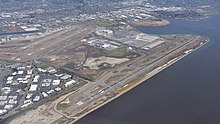
Oakland residents have access to the three major airports of the San Francisco Bay Area:
The city has regional and long-distance passenger train service provided by
Historically, the city was served by several train companies, which terminated in different terminals.
Mass transit and bicycling

Data compiled in 2007 by the United States Census Bureau before gasoline price spikes in 2008, showed that 24.3% of Oaklanders used public transportation, walked or used "other means" to commute to work, not including remote work,[199] with 17% of Oakland households being "car free" and/or statistically categorized as having "no vehicles available."[200]
Bus transit service in Oakland and the inner

Intercity bus companies that serve Oakland include Greyhound, BoltBus, USAsia, and Hoang Transportation. Megabus no longer serves Oakland.[201]
The metropolitan area is served by
The
The Oakland City Council adopted a Bicycle Master Plan in 1999 as a part of the Land Use and Transportation (LUTE) element of Oakland's 1998 General Plan. The creation of the plan was to promote alternatives to the private automobile.[202] The Oakland City Council reaffirmed the bike plan in 2005, revised it in 2007, and reaffirmed it in 2012.[203][202] From 1999 to 2007, the city installed 900 bike racks throughout Oakland, accommodating over 2,000 bicycles.[204] By the end of 2017, over 160 bikeway miles and 9,900 bike parking spaces were constructed.[205] Facilities for parking thousands of bicycles have been installed downtown and in other commercial districts throughout Oakland.[206] According to the U.S. Census Bureau's 2011 American Community Survey, Oakland came in seventh place out of the 100 largest cities in the nation by percentage of people that chose to commute by bike in 2011.[207]
Motorized scooters
In July 2019, the City of Oakland Department of Transportation announced that it had issued official permits for the deployment of shared e-scooters to four companies:
Bridges, freeways, and tunnels
Oakland is served by several major highways: Eastbound Bay Bridge traffic entering Oakland then splits into three freeways at the

At the time of the
Two underwater tunnels, the
In the hills, the Leimert Bridge crosses Dimond Canyon, connecting the Oakmore neighborhood to Park Boulevard. The Caldecott Tunnel carries Highway 24 through the Berkeley Hills, connecting central Contra Costa County to Oakland. The Caldecott has four bores.
Oakland Slow Streets Program

On April 11, 2020, the City of Oakland launched its Slow Streets Program.[210] This was facilitated in part by the sudden decrease of vehicle traffic that resulted from the state-wide stay-at-home order and school closures in response to the spread of the COVID-19 in California.[211] The goal of the program was to "support safe physical activity and alleviate overcrowding in parks and on trails by discouraging through traffic."[212] This was accomplished by closing 74 miles of streets to through traffic.[213]
Over the course of three months the city installed "soft closure" barriers consisting of signage, traffic cones, and barricades in over 21 miles of city streets.[210] While the primary goal at the time was to encourage socially distanced outdoor physical activities like biking, walking, and jogging, the long term implementation of the Slow Streets Program contributed to the city's traffic calming measures and promoted alternatives to car use as well.[212]
Although the Slow Streets Program was initially praised for its rapid implementation and prioritization of pedestrian safety, the Oakland Department of Transportation quickly came under fire for its failure to collect feedback that represented the opinions of the diverse range of residents whom the program affected.[213] The high engagement with online surveys by wealthy white residents initially suggested an almost universally positive reaction to the program.[214] The disproportionately low number of responses from residents of East Oakland—a largely Black and Latino and low-income area—revealed both the oversight of city officials as well as the shortcomings of urban planning systems' ability to equally benefit different social groups, which consequently perpetuates inequalities like the transport divide.
After the flaws of the feedback forms were brought to light, city planners made concentrated efforts to meet with representatives from different community groups who in turn stressed that simply closing streets to through traffic was not enough to protect pedestrians from dangerous driving.[214] In response the city expressed its commitment to its local residents calling for road traffic safety by rolling out Slow Streets: Essential Places, a phase of the program which installed cones and signage at dangerous traffic areas in order to make grocery stores, COVID-19 test sites, and food distribution sites easily and safely accessible.[211]
Freight rail
Freight service, which consists primarily of moving shipping containers to and from the Port of Oakland, is provided today by Union Pacific Railroad (UP), and to a lesser extent by BNSF Railway (which now shares the tracks of the UP between Richmond and Oakland).
Historically, Oakland was served by several railroads. Besides the transcontinental line of the Southern Pacific, there was also the Santa Fe (whose Oakland terminal was actually in Emeryville), the
Shipping
As one of the three major ports on the West Coast of the United States, the Port of Oakland is the largest seaport on San Francisco Bay and the fifth busiest container port in the United States. It was one of the earliest seaports to switch to containerization and to intermodal container transfer,[215] thereby displacing the Port of San Francisco, which never modernized its waterfront. One of the earlier limitations to growth was the inability to transfer containers to rail lines, all cranes historically operating between ocean vessels and trucks. In the 1980s, the Port of Oakland began the evaluation of development of an intermodal container transfer capability, i.e., facilities that now allow trans-loading of containers from vessels to either trucks or rail modes.[216]
Utilities
Oakland tops the list of the 50 largest US cities using electricity from renewable sources.[217]
Healthcare

Originating in Oakland,
Alta Bates Summit Medical Center, an East Bay hospital system, maintains its Summit Campus in the neighborhood known as "Pill Hill" north of downtown. Until 2000, it was the Summit Medical Center before merging with Berkeley-based Alta Bates. All campuses now operate under the Sutter Health network.
Alameda Health System is an integrated public health care system organized as a public hospital authority. It operates five Alameda County hospitals including Oakland's Highland Hospital and four primary care medical clinics including Oakland's Highland Wellness Center and Eastmont Wellness Center.
Children's Hospital Oakland is the primary medical center specializing in pediatrics in the East Bay. It is a designated Level I pediatric trauma center and the only independent children's hospital in Northern California.
There are also several community health centers in Oakland.[219] Some examples include Lifelong Medical Care, Asian Health Services, and Roots Community Health Center.
Notable people
International relations
Sister cities
Oakland has 13
| City | Division | Country | Year of Partnership |
|---|---|---|---|
| 1962 | |||
| Sekondi-Takoradi | 1975 | ||
| 1975 | |||
| Dalian | Liaoning | 1982 | |
| 1999 | |||
| Santiago de Cuba | Santiago de Cuba | 2000 | |
| Da Nang | N/A | 2005 | |
| Benin City | Edo | 2010 | |
| Port-de-Paix | Nord-Ouest | 2011 | |
| Oakleigh | Division of Hotham | 2020 | |
| Foshan | Guangdong | ||
| Bauchi | Bauchi | 2010 | |
| Ocho Rios | Saint Ann | 1986 |
Friendship cities
Oakland has 18 friendship cities:[220]
 Agadir, Morocco
Agadir, Morocco Bahir Dar, Ethiopia
Bahir Dar, Ethiopia Changping District, Beijing, China
Changping District, Beijing, China Chengdu, Sichuan, China
Chengdu, Sichuan, China Guangzhou, Guangdong, China
Guangzhou, Guangdong, China Haikou, Hainan, China
Haikou, Hainan, China Jing'an District, Shanghai, China
Jing'an District, Shanghai, China Jinzhou, Liaoning, China
Jinzhou, Liaoning, China Jurong, Jiangsu, China
Jurong, Jiangsu, China Maoming, Guangdong, China
Maoming, Guangdong, China Mianyang, Sichuan, China
Mianyang, Sichuan, China Nanning, Guangxi, China
Nanning, Guangxi, China Pudong, Shanghai, China
Pudong, Shanghai, China Qingdao, Shandong, China
Qingdao, Shandong, China Tanggu District, Tianjin, China
Tanggu District, Tianjin, China Ulaanbaatar, Mongolia
Ulaanbaatar, Mongolia Weifang, Shandong, China
Weifang, Shandong, China
See also
- Northern California Megaregion
- List of cities and towns in the San Francisco Bay Area
- List of tallest buildings in Oakland, California
- Oakland Ebonics controversy
- USS Oakland, 3 ships
Notes
- ^ a b From 15% sample
- ^ The homicide rate is not the same as murder rate. Murders are a subset of homicides. In 2000, for insurance, there were 109 homicides in Oakland, of which 102 were classified as murders;[125] similarly in 2018, there were 75 homicides: 68 murders and 7 categorized as justifiable homicides or killings in self-defense.[126]
References
- ^ SCANLON, TOM (November 22, 1992). "The New Motown : Call it 'Oaktown.' It's funky, it's thriving. It's definitely not L.A. or New York. And it just may be the Hip-Hop Capital of America". Los Angeles Times.
- ^ "Debate over Oakland motto exposes racial divide, identity crisis". sfchronicle.com. April 16, 2016.
- ^ "California Cities by Incorporation Date". California Association of Local Agency Formation Commissions. Archived from the original (Word) on February 21, 2013. Retrieved March 27, 2013.
- ^ a b Joseph Eugene Baker (1914). Past and present of Alameda County, California. Vol. 1. S.J. Clarke. pp. 55, 65, 358, 360–361.
- ^ a b "Oakland's Early History, Edson F. Adams, 1932". Freepages.genealogy.rootsweb.ancestry.com. Retrieved November 26, 2013.
- ^ "Elected Officials". City of Oakland, California. Archived from the original on January 31, 2015. Retrieved January 31, 2015.
- ^ "City Officials". City of Oakland. Retrieved January 10, 2023.
- ^ a b "Senators". State of California. Retrieved March 18, 2013.
- ^ a b "Members Assembly". State of California. Retrieved March 18, 2013.
- ^ a b "California's 12th Congressional District - Representatives & District Map". Civic Impulse, LLC. Retrieved March 9, 2013.
- ^ "2021 U.S. Gazetteer Files". United States Census Bureau. Retrieved September 5, 2021.
- ^ "Oakland". Geographic Names Information System. United States Geological Survey, United States Department of the Interior.
- ^ a b "QuickFacts: Oakland city, California". United States Census Bureau. Retrieved September 7, 2021.
- ^ "Zip Code Lookup". USPS. Retrieved April 11, 2020.
- ^ "In Photos: Goodbye, Oaklandnet.com". City of Oakland. April 20, 2018. Retrieved October 1, 2018.
- ^ "Hello, Oaklandca.gov!". City of Oakland. April 23, 2018. Retrieved October 1, 2018.
- ^ "oaklandnet.com Archived April 10, 2021, at the Wayback Machine" was the past official website before April 2018, on which date the domain was permanently moved to "oaklandca.gov".
- ^ "Port of Oakland – History". Port of Oakland. Retrieved January 31, 2018.
- ^ "Legal Briefs" (PDF). City of Oakland Office of the City Attorney. May 2002. Archived from the original (PDF) on September 24, 2015. Retrieved March 19, 2015.
- ^ a b Joseph Eugene Baker (1914). Past and present of Alameda County, California. Vol. 1. S.J. Clarke. pp. 49–51.
- ^ Joseph Eugene Baker (1914). Past and present of Alameda County, California. Vol. 1. S.J. Clarke. p. 365.
- ^ Milliken, Randall. "Ohlone Tribal Regions Map". Archived from the original on August 13, 2007. Retrieved April 15, 2007.
- ^ "Oakland-california.co.tv". Oakland-california.co.tv. Archived from the original on April 11, 2011. Retrieved April 19, 2012.
- ^ "Oaklandcaliforniarealestate.biz". Oaklandcaliforniarealestate.biz. Archived from the original on March 24, 2012. Retrieved April 19, 2012.
- ISBN 978-0878351282. Retrieved July 29, 2020.
- ^ "History of the Port of Oakland: 1850–1934" (PDF). waterfrontaction.org. p. 1.
- ^ Statutes of California, 1852, p.180
- ^ Statutes of California, 1854, pp.183–187
- ISBN 9780195106503.
- )
- OCLC 55136302.
- ^ Levi, Ryan (May 9, 2019). "How Old Oakland's Historic Buildings Survived Decay (and Demolition)". KQED. Archived from the original on May 10, 2019. Retrieved May 10, 2019.
- ProQuest 103474660.
- OCLC 785865143.
- OCLC 48003418.
- ^ PMID 18014177.
- PMID 18010342.
- ISBN 978-0-615-57936-8
- ^ "Oakland History Room. 1917 promotional photograph of a day's output at the Chevrolet factory". Oaklandhistory.com. Archived from the original on March 23, 2012. Retrieved April 19, 2012.
- ^ Wes Hammond. "Highway Nostalgia. Manufacturing Trucks Adjacent to the Lincoln Highway: Fageol Truck and Coach Company. Oakland, California, 1916–1938". The Traveler: The Newsletter of the Lincoln Highway Association—California Chapter. Lincolnhighwayassoc.org. Archived from the original on March 19, 2012. Retrieved April 19, 2012.
- ^ "Vintage Tractors. 'Fageol'". Vintagetractors.com. January 7, 1919. Archived from the original on June 9, 2012. Retrieved April 19, 2012.
- ^ "Photo collection: 'New or greatly enlarged industrial establishments of Oakland and East Bay cities.' by Oakland (Calif.) Chamber of Commerce. ca. 1917. Oakland Public Library, Oakland History Room". Content.cdlib.org. February 24, 2007. Archived from the original on July 23, 2013. Retrieved April 19, 2012.
- ^ "Oakland Tribune, May 5, 1929. 'Chrysler plant'". Newspaperarchive.com. Retrieved April 19, 2012.
- ^ "East Oakland Community Information Book 2001" (PDF). Alameda County Health Services Agency. Archived from the original (PDF) on September 10, 2008.
- ISBN 0-89815-172-4
- ^ "Aerofiles.com. 'Durant'". Aerofiles.com. Retrieved April 19, 2012.
- ^ "U.S. Centennial of Flight Commission. 'The U.S. Post Office Flies the Mail, 1918–1924'". Centennialofflight.gov. Archived from the original on January 6, 2012. Retrieved April 19, 2012.
- ^ Western Aerospace Museum. Oakland Airport Timeline. Archived October 16, 2015, at the Wayback Machine
- ^ "H.G. Prince Employees [1918]". Oakland Museum of California. Archived from the original on June 26, 2003.
Oakland's location, where rail and water transportation meet, made it an ideal site for canneries. Shippers brought produce from all over California for canning at several large plants—including the Josiah Lusk Canning Company, the Oakland Preserving Company (which developed the Del Monte brand), and the California Packing Company, which took over the H. G. Prince Company between 1925 and 1930. In 1943, the Oakland Tribune reported that the $100,000,000 canning industry in Oakland ranked second only to shipbuilding in value.
- ^ Zinko, Carolyne (September 26, 2007). "WWII meant opportunity for many women, oppression for others". The San Francisco Chronicle.
- ^ Ruben Llamas, Eye from the Edge: A Memoir of West Oakland, California
- ^ UNITED STATES, v. NATIONAL CITY LINES, Inc., et al.—186 F.2d 562—AltLaw Archived November 16, 2009, at the Wayback Machine
- ^ a b Elena Conis (2002). "From Horses to Hybrid: A Century of East Bay Transport". Journalism.berkeley.edu. Archived from the original on March 9, 2012. Retrieved April 19, 2012.
- ^ Weir, Stan (November 22, 2005). "1946: The Oakland General Strike". libcom.org. Archived from the original on December 30, 2011. Retrieved December 31, 2011.
- ^ "Vallerga v. Dept. Alcoholic Bev. Control - 53 Cal. 2d 313, 347 P.2d 909, 1 Cal. Rptr. 494 - Wed, 12/23/1959". California Supreme Court Resources, Stanford Law School. Retrieved June 21, 2023.
- ISBN 978-0-520-20415-7.
- ISBN 978-0-393-73080-7. Retrieved April 19, 2012.
- ^ Inside the Panther Revolution, Robyn Cean Spencer, Chapter 13, p. 302
- ^ monthlyreview.org
- ^ Tyler, Carolyn (October 19, 2016). "Oakland Museum of CA celebrates 50th anniversary of Black Panthers". abc7news.com.
- ISBN 978-0-520-20242-9.
- ^ "Bay Area Census – City of Oakland – 1970–1990 Census data". www.bayareacensus.ca.gov. Retrieved October 22, 2019.
- ^ Catastrophe: The 100 Greatest Disasters of All Time, Stephen J. Spignesi, Citadel, 2004, pp 292–94
- ^ "Some faults revealed by firestorm remain uncorrected". www.ktvu.com. Archived from the original on January 22, 2012. Retrieved July 24, 2012.
- ^ Edward Iwata, of the examiner staff (February 16, 1997). "On the road to economic success, where we work". San Francisco Examiner.
- ^ Gammon, Robert (January 3, 2007). "Inflating the Numbers, The Brown administration came very close on the 10K Plan. So why the grade inflation?". East Bay Express. Archived from the original on December 30, 2008.
- ^ Salazar, Alex (Spring 2006). "Designing a Socially Just Downtown". National Housing Institute (145). Archived from the original on December 12, 2006.
- ^ KTVU – Investigation reveals East Bay city paying out extraordinary police abuse settlements November 14, 2011 Archived August 2, 2014, at the Wayback Machine
- ^ "Wall Street protesters: We're in for the long haul" Archived February 2, 2016, at the Wayback Machine, Bloomberg Businessweek. Accessed: October 3, 2011.
- ^ Lessig, Lawrence (October 5, 2011). "#OccupyWallSt, Then #OccupyKSt, Then #OccupyMainSt". Huffington Post. Retrieved October 6, 2011.
- ^ Levin, Sam (June 2018). "'We're being pushed out': The displacement of black Oakland". The Guardian.
- ^ "Update: Fire Chief Defends Response To Deadly Ghost Ship Fire". SFGATE. May 16, 2019. Retrieved January 9, 2021.
- ^ Shalby, Colleen. "Oakland becomes 2nd U.S. city to decriminalize magic mushrooms". Los Angeles Times. Retrieved June 5, 2019.
- ^ Branson-Potts, Hailey (June 22, 2019). "How a trip on magic mushrooms helped decriminalize psychedelic plants in a California city". Los Angeles Times. Retrieved June 23, 2019.
- ^ Cowan, Jill; Dougherty, Conor (January 15, 2019). "Homeless Mothers Are Removed From an Oakland House". The New York Times. Retrieved January 15, 2020.
- ^ "Sheriff's deputies with guns drawn evict homeless moms from Oakland home". DTVU. January 15, 2020. Retrieved January 15, 2020.
- ^ Elassar, Alaa. "Homeless mothers with Oakland's 'Moms 4 Housing' have been forcibly evicted from a vacant home they were occupying". CNN. Retrieved January 15, 2020.
- ^ Ravani, Sarah (January 20, 2019). "Moms 4 Housing: Deal reached to negotiate sale of West Oakland house to nonprofit". San Francisco Chronicle. Archived from the original on January 21, 2020. Retrieved January 21, 2020.
- ^ a b c Robert Zeglinski (April 20, 2023). "Oakland unbelievably lost all three of its pro sports teams in just 5 years". USA TODAY SPORTS. Retrieved April 20, 2023.
- ^ "Oakland and Alameda Waterfront Parks". Waterfront Action, Inc. April 19, 2011. Archived from the original on October 2, 2011. Retrieved October 29, 2011.
- ^ Schmidt, David; Bürgmann, Roland (1999). "Modeling surface creep on the Hayward fault using rate-and-state friction". The Berkeley Seismological Laboratory. The Regents of the University of California. Archived from the original on September 27, 2011. Retrieved August 8, 2011.
- ^ Said, Carolyn (July 20, 2011). "S.F., Oakland in top 10 most walkable U.S. cities". San Francisco Chronicle. Retrieved August 8, 2011.
- ^ Lake Merritt Institute. Retrieved April 12, 2011. Archived February 24, 2015, at the Wayback Machine
- ^ "A Brief History". Lake Merritt Institute. Archived from the original on November 9, 2010. Retrieved August 24, 2011.
- ^ "Relocation information: Oakland Facts". Chamber of Commerce. Archived from the original on September 3, 2011. Retrieved July 13, 2011. As published in 1993 by Rand McNally.
- ^ "Oakland, California – Climate Summary". Wrcc.dri.edu. Retrieved April 19, 2012.
- ^ NOAA. Retrieved July 26, 2022.
- ^ "NowData – NOAA Online Weather Data". National Oceanic and Atmospheric Administration. Retrieved May 14, 2021.
- ^ "Summary of Monthly Normals 1991–2020". National Oceanic and Atmospheric Administration. Archived from the original on August 8, 2023. Retrieved May 14, 2021.
- ^ "US Census Quick Facts of Oakland (using 2020 data)". Census.gov. Retrieved August 12, 2021.
- ^ U.S. Census Bureau. Retrieved August 12, 2021.
- ^ Farrag, Hebah; Flory, Richard; Loskota, Brie (November 9, 2012). "12 – Appendix: Geographic Profile of Oakland". Faithful Action: Working with Religious Groups in Disaster Planning, Response, and Recovery (Report). University of Southern California (USC). Retrieved July 29, 2023.
- ^ "U.S. Census Bureau QuickFacts: Oakland city, California". www.census.gov. Retrieved August 1, 2023.
- ^ U.S. Census Bureau.
- ^ a b c "California – Race and Hispanic Origin for Selected Cities and Other Places: Earliest Census to 1990". U.S. Census Bureau. Archived from the original on August 12, 2012.
- ^ "P004: Hispanic or Latino, and Not Hispanic or Latino by Race – 2000: DEC Summary File 1 – Oakland city, California". United States Census Bureau. Retrieved January 26, 2024.
- ^ "P2: Hispanic or Latino, and Not Hispanic or Latino by Race – 2010: DEC Redistricting Data (PL 94-171) – Oakland city, California". United States Census Bureau. Retrieved January 26, 2024.
- ^ "P2: Hispanic or Latino, and Not Hispanic or Latino by Race – 2020: DEC Redistricting Data (PL 94-171) – Oakland city, California". United States Census Bureau. Retrieved January 26, 2024.
- ^ U.S. Census Bureau. July 1, 2022. Retrieved May 27, 2021.
- ^ https://data.census.gov/profile/Oakland_city,_California?g=160XX00US0653000
- ^ "Washington: A World Apart". The Washington Post. Retrieved May 9, 2014.
- ^ "Community Facts". United States Census Bureau. Retrieved May 14, 2014.
- ^ Winter, Michael. "New measure ranks San Francisco the 'smartest' U.S. city". USA Today. Retrieved May 14, 2014.
- ^ Jun S. (June 17, 2016). "Oakland Demographics". oakland.com. Archived from the original on September 28, 2016. Retrieved September 28, 2016.
- ^ "Community Facts". United States Census Bureau. Retrieved May 9, 2014.
- ^ "Milestones in 2013". State of the City 2013 Report. Retrieved May 9, 2014.
- ^ a b c Designing a Socially Just Downtown Archived December 12, 2006, at the Wayback Machine, NHI, by Alex Salazar, Spring 2006, retrieved August 12, 2007
- ^ "U.S. Census website". United States Census Bureau. Retrieved January 31, 2008.
- ^ Ness, Carol (April 1, 2001). "S.F.'s Diversity Comeuppance". San Francisco Chronicle. Retrieved August 24, 2011.
- ^ "The Top 10 Most Diverse Cities in America". CNBC.com. May 17, 2011. Archived from the original on January 20, 2013. Retrieved June 13, 2012.
- ^ "Most & Least Ethnically Diverse Cities in the U.S." WallletHub. February 12, 2019. Retrieved August 23, 2019.
- ^ Kuruvila, Matthai (March 11, 2011). "Oakland's black experience still inherent to city". The San Francisco Chronicle.
- ^ Ahearn, Lorraine (March 22, 2009). "Census: Blacks are moving to the South". News-Record.com. Archived from the original on March 25, 2009. Retrieved April 19, 2012.
- ^ "Oakland city, California—Fact Sheet—American FactFinder". Factfinder.census.gov. Archived from the original on February 11, 2020. Retrieved April 19, 2012.
- ^ Johnson, Jason B. (June 5, 2006). "News Analysis / In Oakland, Jerry Brown Finds All Politics Is Local / Mayoral front-runner hits the streets". The San Francisco Chronicle.
- ^ Fulbright, Leslie (April 9, 2007). "S.F. moves to stem African American exodus". SF Gate. Archived (PDF) from the original on August 4, 2009. Retrieved April 19, 2012.
- ^ Frey, William H. (May 4, 2011). "Melting Pot Cities and Suburbs: Racial and Ethnic Change in Metro America in the 2000s" (PDF). Metropolitan Policy Program. Brookings Institution. Archived from the original (PDF) on August 5, 2011. Retrieved August 4, 2011.
- ^ "Nation Sees Effects of 'Day Without Immigrants'". NPR News. May 1, 2006. Retrieved May 31, 2019.
- ^ Lesbians Step Out With Pride: DeFao, Janine] San Francisco Chronicle, August 27, 2006
- ^ "2000 Census information on Gay and Lesbian Couples, by Incorporated place Incorporated place, by highest percentage". www.gaydemographics.org. Archived from the original on June 9, 2002.
- ^ a b "Gentrification and Disinvestment 2020 » NCRC". NCRC. June 17, 2020. Retrieved November 3, 2020.
- ^ "Oakland, S.F. neighborhoods fastest gentrifying in U.S." The Mercury News. June 18, 2020. Retrieved November 3, 2020.
- ISSN 0261-3077. Retrieved November 3, 2020.
- ^ a b "Gentrification risk | Bay Area Equity Atlas". bayareaequityatlas.org. Retrieved November 3, 2020.
- ^ a b c Rick Hurd & Harry Harris, Sad milestones in Oakland as deadly violence explodes in 2020, Bay Area News Group (January 1, 2021).
- ^ a b Rick Hurd, Harry Harris & David DeBolt, 2018 Review: Oakland murders dip to lowest level since 1999; major crimes fall regionally, Bay Area News Group (January 2, 2019).
- ^ a b Harry Harris, Oakland's homicide numbers rise for first time in two years, Bay Area News Group (December 31, 2015).
- ^ a b Jim Herron Zamora, Murder rates dropped in S.F., Oakland in '96, San Francisco Chronicle (January 2, 1997).
- ^ a b c d e f g h i j k l m n Harry Harris, Oakland sees biggest drop in homicides since 2004, Bay Area News Group (December 31, 2013).
- ^ Tammerlin Drummond, Oakland killings down in 2014 but still way too many, Bay Area News Group (March 24, 2015).
- ^ a b Mark Hedin, Oakland: Rash of homicides in late 2016 push year's toll to 85, Bay Area News Group (March 10, 2017).
- ^ Darwin BondGraham, Oakland Leaders Attribute Drop in Homicides and Shootings to Ceasefire Program, East Bay Express (January 9, 2017).
- ^ a b Jakob Rodgers, ‘A kind of reset’: Killings and shootings in Oakland, East Bay ease slightly in 2022 after violent, two-year stretch, Mercury News (January 1, 2023).
- ^ a b c d Bobby McCarthy & Sarah Lawrence, Crime Trends in the City of Oakland: A 25-Year Look (1987–2012)., Chief Justice Earl Warren Institute on Law & Social Policy, University of California, Berkeley School of Law.
- ^ .
- CBS San Francisco. Bay City News. November 22, 2010. Retrieved October 29, 2011.
- ^ Robert Rogers and Harry Harris (January 12, 2013). "Oakland police vow to intensify anti-violence efforts after four shooting deaths in six hours". East Bay Times. Inside Bay Area. Retrieved October 26, 2017.
- ^ Harry HarrisOakland Tribune. "Gradually, Oakland a less deadly place". Inside Bay Area. Retrieved April 19, 2012.
- ^ Kerr, Dara (January 3, 2011). "Oakland memorializes the 94 homicides of 2010". North Oakland News. Retrieved April 19, 2012.
- ^ Spiker, Steve; Garvey, John; Arnold, Kenyatta; Williams, Junious (March 9, 2009). "Homicides in Oakland" (PDF). Urban Strategies Council. Archived from the original (PDF) on October 3, 2011. Retrieved October 29, 2011.
- San Jose Mercury News. Retrieved August 16, 2013.
- ^ Will Kane (August 15, 2013). "8 arrested in Oakland crime crackdown". SFGate. Retrieved August 16, 2013.
- ^ "Oakland Boosts 'Operation Ceasefire' After Baby, Father Killed « CBS San Francisco". Sanfrancisco.cbslocal.com. August 8, 2013. Retrieved August 8, 2013.
- ^ Will Kane (August 10, 2013). "Oakland police's new push on Ceasefire program". SFGate. Retrieved August 16, 2013.
- ^ "North American Container Traffic: 2011 Port Ranking by TEUs" (PDF). American Association of Port Authorities. Retrieved May 11, 2013.
- ^ "Facts & Figures". Port of Oakland. Retrieved May 9, 2014.
- ^ "Making California Ports More Competitive" (PDF). California Chamber of Commerce. Archived from the original (PDF) on May 12, 2014. Retrieved May 9, 2014.
- ^ "Oakland: Economy". City-Data.com. 2009. Retrieved May 31, 2010.
- ^ "Transportation Storage and Distribution Managers Data for Oakland, Fremont, Hayward, California". Archived from the original on July 8, 2011. Retrieved August 29, 2011.
- ^ "Oakland CEDA—Major Employers". Business2oakland.com. Archived from the original on May 29, 2010. Retrieved April 19, 2012.
- ^ Avalos, George (June 17, 2011). "Shining Internet star Pandora could be a boost for downtown Oakland". Oakland Tribune. Retrieved June 20, 2011.
- ^ Avalos, George (July 24, 2011). "New economy companies bolster Oakland's workforce". Contra Costa Times. Retrieved August 29, 2011.
- ^ "Top 100 U.S. Metro Economies" (PDF). Metro Economics Report. Archived from the original (PDF) on March 31, 2014. Retrieved May 14, 2014.
- ^ Kiernan, John. "Best & Worst Cities to Start a Career". Wallet Hub. Retrieved May 14, 2014.
- ^ Torres, Bianca. "Tenant spillover from San Francisco to the East Bay tops 300,000 square feet". San Francisco Business Times. Retrieved May 15, 2014.
- ^ "City of Oakland, California: Comprehensive Annual Financial Report for the Year Ended June 30, 2020" (PDF). p. 213.
- ^ "Tourism Facts and Figures". Visit Oakland. Archived from the original on April 11, 2014. Retrieved May 10, 2014.
- ^ King, Danny. "Hotel Demand Thriving in three secondary U.S. markets". Travel Weekly. Retrieved May 10, 2014.
- ^ Robert, Mandelbaum. "Recovery Momentum picks up outside major markets". Hotel Management. Archived from the original on May 12, 2014. Retrieved May 10, 2014.
- ^ "The 45 Places to Go in 2012". The New York Times. January 6, 2012. Retrieved May 9, 2014.
- ^ "America's Coolest Cities". Forbes. Retrieved May 9, 2014.
- ^ "The 10 Most Exciting Cities in America". Movoto. Retrieved May 9, 2014.
- ^ "America's Most Hipster Cities". Thrillest. November 7, 2013. Retrieved May 9, 2014.
- ^ Boyd, Maya (March 10, 2014). "Travel" The top 5 things to do in California". Metro Travel. Retrieved May 14, 2014.
- ^ "The Official Travel and Tourism Website of the United States". Retrieved June 11, 2011.
- ^ "America's Top Twelve ArtPlaces". Art Place America. Archived from the original on May 4, 2014. Retrieved May 9, 2014.
- ^ "Top 25 Cities for Designers and Artists". Artbistro. Archived from the original on May 14, 2014. Retrieved May 14, 2014.
- ^ "From the dept. of nightlife | Oakland Tribune Outtakes". Ibabuzz.com. November 5, 2008. Archived from the original on March 13, 2012. Retrieved April 19, 2012.
- ^ "Move Over Vegas, These Are the New Sin Cities". Forbes. Retrieved May 9, 2014.
- ^ Robert Taylor, Staff Writer (August 14, 2007). "Oakland art galleries creating loud 'Murmur' on first Fridays". InsideBayArea.com. Retrieved August 23, 2007.
- ^ Wollan, Malia (October 11, 2012). "A Monthly Night of Art Outgrows its Name". The New York Times. Retrieved May 9, 2014.
- ^ "Oakland's Art Murmur: A New Roar?". Oakland Art Murmur. Archived from the original on May 13, 2014. Retrieved May 9, 2014.
- ^ LeBeau, Eleanor (2006). "Sampling Oakland" (PDF). Art Papers (Nov/Dec): 68. Archived from the original (PDF) on March 6, 2007. Retrieved June 12, 2011.
- ^ Ward, Jennifer Inez (April 2, 2010). "Here is where the Gertrude Stein quote ends". Oakland Local. Archived from the original on April 6, 2010. Retrieved June 12, 2011.
- ^ "HERETHERE" (Press release). City of Berkeley, Office of Economic Development. May 19, 2005. Archived from the original on May 5, 2011. Retrieved June 12, 2011.
- ^ "City Profiles: Oakland" Archived May 12, 2014, at the Wayback Machine. "The Trust for Public Land". Retrieved on July 2, 2013.
- ^ Wang, Annie. "Top 10 Urban Destinations for Nature Lovers". NerdWallet. Retrieved May 14, 2014.
- ^ Peralta Hacienda. "Peraltahacienda.org". Peraltahacienda.org. Retrieved April 19, 2012.
- ^ Oakland Municipal Code. Accessed August 31, 2007. [dead link]
- ^ "Peer Review of Base-Isolation Retrofit". Oakland City Hall. Wiss, Janney, Elstner Associates, Inc. 2007. Archived from the original on February 4, 2008. Retrieved October 29, 2011.
- ^ Gammon, Robert (November 10, 2011). "Breaking news: Jean Quan wins mayor's race". East Bay Express. Archived from the original on December 12, 2011. Retrieved October 29, 2011.
- ^ California Government Code § 23004
- ISBN 978-0-7385-4726-8.
- ISBN 978-0-520-92334-8.
- ^ "CA Secretary of State – Report of Registration – February 10, 2019" (PDF). ca.gov. Retrieved March 12, 2019.
- The Cook Political Report. Retrieved November 30, 2014.
- ^ "Great Oakland Public Schools Leadership Center". goleadershipcenter.org. Archived from the original on September 25, 2015.
- ^ "OUSD Oakland Unified School District Fast Facts 2015-2015" (PDF). Oakland Unified School District. Archived from the original (PDF) on December 16, 2022. Retrieved September 23, 2015.
- ^ "Oakland high school test scores lag behind state". Oakland North. September 2, 2013. Retrieved October 7, 2015.
- ^ "Test Results Search – 2013 STAR Test Results (CA Dept of Education)". ca.gov. Archived from the original on September 25, 2015. Retrieved September 24, 2015.
- ^ "Oaklandcharter.net". Oaklandcharter.net. Archived from the original on April 24, 2012. Retrieved April 19, 2012.
- ^ "Pandora – Press Release". press.pandora.com. Archived from the original on April 14, 2018. Retrieved April 14, 2018.
- ^ Goll, David (November 18, 2001). "Cal State launches centers in Oakland.'". Bizjournals.com. Retrieved April 19, 2012.
- ^ Oaklandnet.com Oakland Higher Education Consortium. Archived November 14, 2008, at the Wayback Machine
- ^ "CSU East Bay. Locations". Ce.csueastbay.edu. Retrieved April 19, 2012.
- ^ Liedtke, Michael (August 23, 2011). "MediaNews combining most SF Bay area newspapers into 2 new brands, eliminating 120 jobs". Associated Press. Retrieved August 27, 2011.[dead link]
- ^ "Railroads". localwiki.org.
- ^ "The California Zephyr" from "Streamliner Schedules", original reference from the 1950 Official Guide of railroads"
- U.S. Census Bureau. 2007. Archived from the originalon February 11, 2020. Retrieved October 29, 2011.
- ^ "Oakland city, California – Selected Housing Characteristics: 2005–2007". American Community Survey – 3-Year Estimates (data set). U.S. Census Bureau. 2007. Archived from the original on February 11, 2020. Retrieved October 29, 2011.
- ^ "AIBRA – Find a Station". Archived from the original on April 26, 2015. Retrieved May 2, 2015.
- ^ a b "City of Oakland – Bicycle Master Plan" (PDF). December 2007. p. 15. Archived from the original (PDF) on January 30, 2018. Retrieved February 12, 2018.
[...] creation of a Bicycle Master Plan to promote alternatives to the private automobile [...] Oakland's original plan was completed in 1999 and reaffirmed by City Council in 2005.
- ^ "Let's Bike Oakland! (Bike Plan Update, 2017–18)". Archived from the original on February 13, 2018. Retrieved February 12, 2018.
The 1999 plan was revised in December 2007 [...] and then reaffirmed in 2012.
- ^ "City of Oakland – Bicycle Master Plan" (PDF). December 2007. p. 16. Archived from the original (PDF) on January 30, 2018. Retrieved February 12, 2018.
- ^ "Let Us Count the Ways" (PDF). "I (Bike) Oakland" Newsletter (22 ed.): 8. Winter 2018. Archived from the original (PDF) on February 13, 2018. Retrieved February 12, 2018.
- ^ "Oakland, California, USA – Discover World". www.discoverworld.com. Archived from the original on December 8, 2017. Retrieved December 7, 2017.
- ^ "Linus Bike Commends Oakland After It Is Listed in Top 10 Commuter Bike Cities". PRWeb. November 15, 2012. Retrieved December 25, 2012.
- ^ "OakDOT Announces Permits for Shared E-Scooters". City of Oakland. Retrieved November 20, 2019.
- ^ "Oakland OKs 3,500 rental e-scooters from Bird, Lime, Lyft, Clevr". SFChronicle.com. July 2, 2019. Archived from the original on December 4, 2019. Retrieved November 20, 2019.
- ^ a b "Oakland Slow Streets' program opens 74 miles of streets for pedestrians and cyclists". COVID Mobility Works. Retrieved October 28, 2021.
- ^ a b Fermoso, Jose (November 25, 2020). "What do we know about Slow Streets and safety? Here's what data and residents have to say". The Oaklandside. Retrieved October 28, 2021.
- ^ a b "Oakland's Slow Streets & Essential Places". City of Oakland. Retrieved October 28, 2021.
- ^ a b Bliss, Laura (January 6, 2021). "'Slow Streets' Disrupted City Planning. What Comes Next?". Bloomberg CityLab. Retrieved October 28, 2021.
- ^ a b Sharma Rani, Rikha (October 8, 2020). "How Covid-19 Inspired Oakland to Get Real About Equitable Urban Planning". Next City. Retrieved October 28, 2021.
- ^ Initial Study: Intermodal Interface Demonstration Project, Port of Oakland, Oakland, California, Earth Metrics and Korve Engineerning, December 20, 1989
- ^ "Port Of Oakland, Oakland Estuary". Glenn Franco Simmons. Archived from the original on December 8, 2017. Retrieved December 7, 2017.
- ^ "What is the definition of sustainability, development and resources". Tech Stuffed. Archived from the original on July 23, 2014. Retrieved August 27, 2015.
- ISBN 978-0-7879-5258-7.
- S2CID 11934476.
- ^ a b "Interactive City Directory". Sister-cities.org. Archived from the original on April 6, 2017. Retrieved April 5, 2017.
External links
- Official website – oaklandca.gov
- Visit Oakland: Oakland Convention and Visitors Bureau Archived February 2, 2011, at the Wayback Machine
- Oakland on LocalWiki
- "Oakland". U.S. City Open Data Census. UK: Open Knowledge Foundation. Archived from the original on March 28, 2014. Retrieved March 28, 2014.
- "Oakland". C-SPAN Cities Tour. January 2016.



